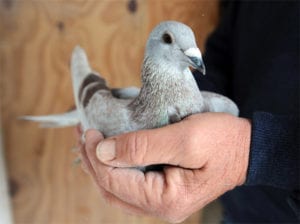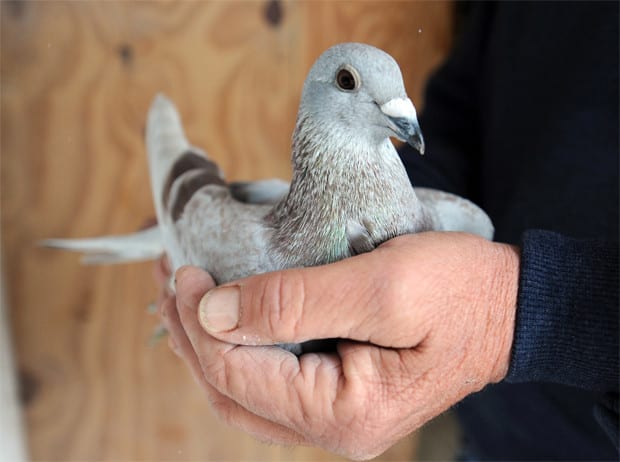Is it dangerous to pick up a bird?
Some birds can bite hard (Northern Cardinals), some can stab (Hairy Woodpeckers), while others can make intimidating noises, But most can’t do any serious damage to a human. Birds do not carry rabies, and are generally at higher risk of catching something from us than vice versa. Wash your hands after handling a bird as a precautionary measure.
But: birds of prey, herons, loons and other birds with strong talons or spear-like beaks can cause serious injury if you do not wear protective gear and take necessary precautions. Please read to the end for specific handling instructions, and do not attempt a rescue if you are not certain you can do so safely.
Two-handed grip for medium-sized birds
Secure the wings by wrapping both your hands around the bird, thumbs on its back, pointing up. Be sure to hold it securely, but be careful not to put pressure on the chest. The bird will instinctively want a place to rest its feet, so let it grab onto your little fingers.
Two-handed grip for small birds
Gently enclose the bird within your hands, leaving room between your fingers to allow the bird to breathe — but not too much room or it will wriggle out.
One-handed grip for small birds
This is similar to the bander’s grip commonly used to stabilize birds for banding (ringing), or to inspect for injuries. Hold the bird’s neck between your index and middle finger while using your thumb and ring finger to secure the wings. Your little finger acts as a perch for the bird’s feet, or you can use your other hand to support the bird from below. If you are not experienced with the bander’s grip, it may be safer to use both hands.
Using a net
A fine-mesh net is often the easiest and safest way to catch a bird. Our volunteers use dollar-store butterfly nets for smaller birds (stick with blue or green nets, avoid red, orange, pink). Nylon fishing nets with large holes are not suitable, as they will not hold a small bird, and risk injuring a larger birds or damaging its feathers.
Gently cover the bird with the net, being careful not to crush the bird’s head, wings or legs with the loop. Hold the net flat against the ground and place one hand over the bird from the outside of the net. Raise the net with that hand, still holding the bird inside the net, and use your other hand to gently extract the bird from the net. Make sure its toes, beak and wings don’t get caught in the netting.
Using a towel, blanket, sweater or jacket
This is usually the easiest way to capture larger birds. Just drop the towel or other piece of fabric over the bird from above, completely covering it. If you cannot cover the whole bird, make sure the head and the wings are covered. Now, just scoop it up in the towel using both hands to ensure that the wings are tucked in.
The towel technique is best for Mourning Doves, because they can shed their feathers to escape, leaving you with a handful of feathers but no bird.
Now what?
Once you have the bird in hand or in a towel or similar, transfer it to a box or, for smaller birds, a plain paper bag, and close the top so the bird cannot escape. The bird may try to fly away even if it badly injured, so please don’t let it. A paper bag does not require air holes, although a box might if it’s airtight.
If you picked up the bird in a towel or similar, make sure its head is uncovered once it’s safely in the box. To do this, or if you need to transfer the bird to another container, please find a small, windowless, enclosed space (e.g. bathroom) so the bird can’t get far if it escapes.
Keep the bird in a dark and quiet place indoors, and do not attempt to give it food or water. Call Safe Wings or another rehabber for further instructions.
Special precautions
Many people worry that birds of prey, such as owls, hawks, falcons and eagles, will bite them. While there’s a very small chance they will, and it can hurt, the real danger lies elsewhere. Raptors have incredibly powerful talons (claws) that they use to grip and kill their prey — and to defend themselves. Do not attempt to handle these birds without thick leather gloves and a thick towel or blanket to protect you from the talons.

Pigeon in New York City (file / credit: STAN HONDA/AFP/Getty Images)
Never attempt to handle a heron, loon or other bird with a long, spear-like beak without wearing eye protection. They will defend themselves by stabbing at your eyes, which can result in fatal injury. Wearing leather gloves and covering the bird with a thick, large towel or blanket to pick it up will further protect both of you from injury.
In many cases, a sick or injured bird will be too weak to struggle or defend itself. However, a bird in distress may lash out in panic. Please do not attempt to capture a potentially dangerous bird unless you understand and are willing to accept the risks.
Other tips for capturing birds
- Move calmly but deliberately
- Crouch if possible
- Approach from behind, but be mindful not to chase birds towards buildings. (Exception: American Woodcocks should be approached from the front.)
- Act quickly. With the exception of young birds that are learning to fly, almost any wild bird that can be approached needs help.
- Do not wait to see if the bird will fly away. Even badly hurt birds will try to get away if they are in a vulnerable position. Just because they can still fly does not mean they don’t have severe internal injuries.
- Do not mistake helplessness for friendliness. Wild birds are naturally afraid of us (with the exception of young birds that have not yet learned to fear us), so if they appear docile, it’s usually because they have head trauma or another severe injury.
- Stress from excessive handling and noise can kill a bird. Please do not pet an injured bird, sing to it, let your children play with it, or let your dog sniff it. Just get it to a rehabber as quickly and as quietly as possible.
Pigeon Patrol Products & Services is the leading manufacturer and distributor of bird deterrent (control) products in Canada. Pigeon Patrol products have solved pest bird problems in industrial, commercial, and residential settings since 2000, by using safe and humane bird deterrents with only bird and animal friendly solutions. At Pigeon Patrol, we manufacture and offer a variety of bird deterrents, ranging from Ultra-flex Bird Spikes with UV protection, Bird Netting, 4-S Bird Gel and the best Ultrasonic and audible sound devices on the market today.
Voted Best Canadian wholesaler for Bird Deterrent products ten years in a row.
Contact us at 1- 877– 4– NO-BIRD, (604) 585-9279 or visit our website at www.pigeonpatrol.ca
Pigeon/Pigeon Patrol / Pigeons Roosting / Vancouver Pigeon Control /Bird Spikes / Bird Control / Bird Deterrent / Pigeon Deterrent? Surrey Pigeon Control / Pest /Seagull deterrent / Vancouver Pigeon Blog / Birds Inside Home / Pigeons in the cities / Ice Pigeons/ What to do about pigeons/ sparrows , Damage by Sparrows, How To Keep Raccoons Away, Why Are Raccoons Considered Pests/ De-fence / Pigeon Nesting/ Bird Droppings / Pigeon Dropping/ woodpecker control/ Professional Bird Control Company/ Keep The Birds Away/ Birds/rats/ seagull/pigeon/woodpecker/ dove/sparrow/pidgeon control/pidgeon problem/ pidgeon control/flying rats/ pigeon Problems/ bird netting/bird gel/bird spray/bird nails/ bird guard

